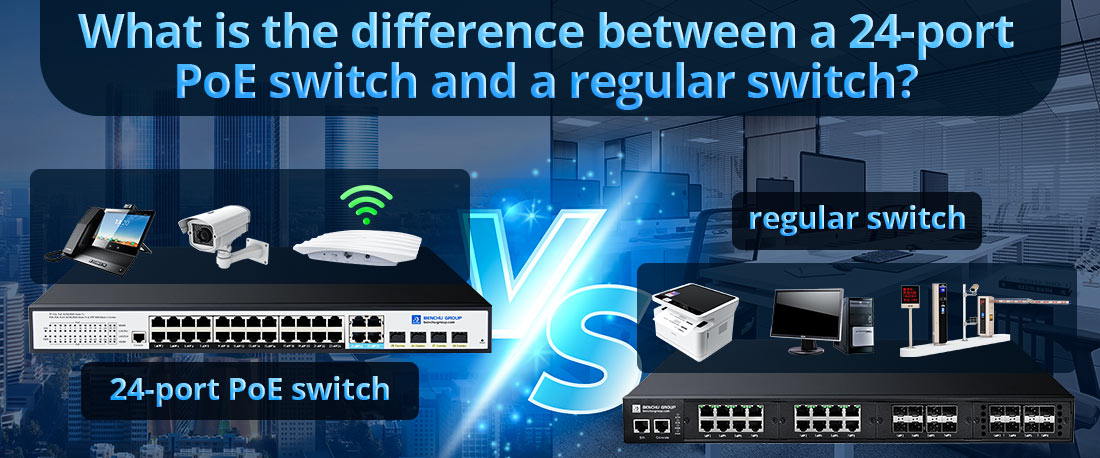
A principal diferença entre um switch PoE de 24 portas e um switch normal (não PoE) está na capacidade de fornecer energia elétrica aos dispositivos conectados por meio de cabos Ethernet. Aqui está uma análise detalhada das diferenças:
1. Capacidade Power Over Ethernet (PoE)
Switch PoE de 24 portas:
Fornece energia e dados através de um único cabo Ethernet para dispositivos compatíveis com PoE (por exemplo, câmeras IP, telefones VoIP, pontos de acesso sem fio).
Está em conformidade com os padrões PoE, como:
--- IEEE 802.3af (PoE): Fornece até 15,4 W por porta.
--- IEEE 802.3at (PoE+): Fornece até 25,5 W por porta.
--- IEEE 802.3bt (PoE++): Fornece até 60 W (Tipo 3) ou 100 W (Tipo 4) por porta.
Elimina a necessidade de adaptadores de energia ou tomadas elétricas separadas para dispositivos.
Troca normal:
--- Transmite apenas dados através de cabos Ethernet.
--- Não fornece energia, exigindo que os dispositivos conectados tenham suas próprias fontes de energia.
2. Casos de uso
Switch PoE de 24 portas:
Ideal para configurações onde os dispositivos requerem energia e dados, como:
--- Sistemas de vigilância IP (câmeras IP).
--- Sistemas de comunicação VoIP.
--- Redes sem fio (pontos de acesso Wi-Fi).
--- Dispositivos IoT (sensores inteligentes, iluminação).
Troca normal:
Adequado para redes onde os dispositivos possuem fontes de alimentação independentes, como:
--- Computadores desktop.
--- Impressoras.
--- Dispositivos de armazenamento de rede (NAS).
3. Flexibilidade de instalação
Switch PoE de 24 portas:
--- Permite a implantação de dispositivos em locais sem tomadas elétricas próximas, como tetos, áreas externas ou locais remotos.
--- Reduz a confusão de cabos combinando energia e transmissão de dados em um único cabo.
Troca normal:
--- Requer que os dispositivos sejam instalados perto de tomadas elétricas ou usem cabos de extensão, limitando a flexibilidade de posicionamento.
4. Orçamento de energia
Switch PoE de 24 portas:
--- Tem um orçamento de energia especificado, que é a potência total máxima que pode fornecer em todas as portas habilitadas para PoE.
--- Exemplo: A Switch PoE de 24 portas com um orçamento de energia de 370 W pode fornecer até 25,5 W em várias portas simultaneamente, dentro do orçamento total.
--- As portas podem alocar energia automaticamente com base nos requisitos do dispositivo.
Troca normal:
--- Não possui orçamento de energia, pois não fornece energia aos dispositivos.
5. Custo
Switch PoE de 24 portas:
--- Geralmente mais caro que os switches normais devido ao hardware adicional de fornecimento de energia e à funcionalidade PoE.
Troca normal:
--- Mais econômico para redes sem requisitos de dispositivos PoE.
6. Consumo de energia
Switch PoE de 24 portas:
--- Consome mais energia porque fornece energia aos dispositivos conectados além de gerenciar o tráfego de dados.
--- O consumo de energia inativo é maior devido ao hardware PoE.
Troca normal:
--- Consome menos energia, pois gerencia apenas a transmissão de dados.
7. Recursos de segurança
Ambos os tipos de switches geralmente incluem recursos de segurança semelhantes, como:
--- Suporte VLAN para isolar o tráfego de rede.
--- Autenticação de porta (802.1X) para evitar conexões não autorizadas de dispositivos.
--- Listas de controle de acesso (ACLs) para maior segurança de rede.
--- No entanto, os switches PoE podem incluir ferramentas avançadas de monitoramento para gerenciar o consumo de energia por porta.
8. Largura de banda e desempenho
Switch PoE de 24 portas:
--- O desempenho é comparável a um switch normal, oferecendo largura de banda semelhante (por exemplo, Gigabit Ethernet ou Ethernet de 10 Gigabit) para transmissão de dados.
--- A funcionalidade PoE adicional não afeta as velocidades de transmissão de dados.
Troca normal:
--- Concentra-se exclusivamente na transmissão de dados, sem considerações adicionais de gerenciamento de energia.
9. Manutenção e solução de problemas
Switch PoE de 24 portas:
--- Os switches PoE gerenciados geralmente incluem ferramentas para monitorar o uso de energia por porta, desligar e ligar dispositivos remotamente e solucionar problemas de dispositivos PoE conectados.
Troca normal:
--- Limitado a diagnósticos e soluções de problemas relacionados a dados.
10. Escalabilidade Futura
Switch PoE de 24 portas:
--- Preparado para o futuro para redes que planejam integrar mais dispositivos PoE, como câmeras IP, pontos de acesso ou sistemas IoT.
--- Reduz a necessidade de fontes de alimentação adicionais durante o dimensionamento.
Troca normal:
--- Pode exigir equipamentos adicionais, como injetores PoE ou dispositivos midspan, para suportar dispositivos habilitados para PoE no futuro.
Conclusão
Um 24 portas Interruptor PoE é uma solução versátil projetada para redes com dispositivos que exigem energia e dados por cabos Ethernet, como câmeras IP, telefones VoIP e pontos de acesso Wi-Fi. Ele simplifica as instalações, aumenta a flexibilidade e oferece suporte ao gerenciamento centralizado de energia.
Por outro lado, um switch regular é uma escolha econômica para redes onde os dispositivos possuem fontes de energia independentes e precisam apenas de conexões de dados. Ao planejar uma rede, a decisão entre os dois depende se a funcionalidade PoE é necessária para os requisitos atuais ou futuros do dispositivo.